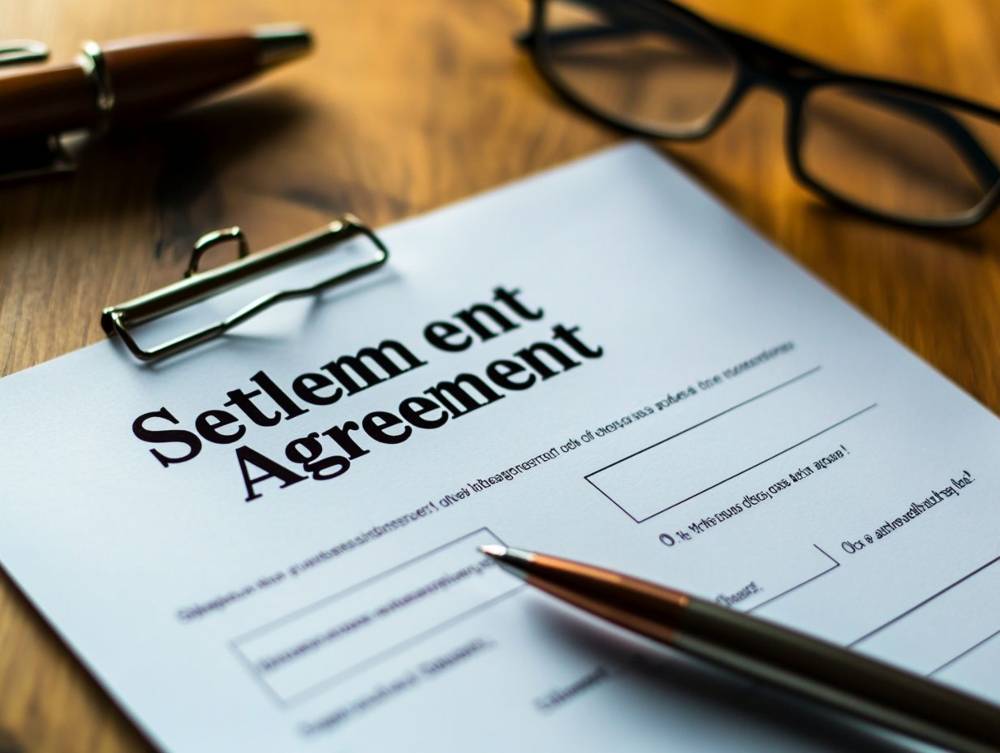
Settlement Agreements: Essential Components Explained
Settlement agreements serve a vital function in the resolution of disputes by providing parties with a clear framework to achieve mutual understanding and comply with legal obligations. This article examines the nature of a settlement agreement and its significance in the dispute resolution process, including negotiation strategies and binding terms. It outlines key components, such as payment terms and confidentiality clauses, to ensure a comprehensive understanding of what constitutes a legally sound document within the legal framework. Whether one is contemplating a settlement or seeking to enhance their knowledge, grasping these essential elements is crucial for effective dispute resolution and legal compliance.
Understanding Settlement Agreements
Settlement agreements are legally binding documents that formalize the resolution of a dispute between parties. They outline the terms of the agreement, the obligations of each party, and the processes involved in achieving a mutually acceptable outcome.
These legal agreements are a critical component in the dispute resolution process, providing clarity and security for all parties involved through enforceable terms and conditions.
By encapsulating the essential elements of negotiation, settlement agreements facilitate effective conflict resolution and ensure compliance with applicable legal requirements, ultimately fostering a more amicable relationship between the parties going forward.
What is a Settlement Agreement?
A settlement agreement is a legally binding contract that effectively resolves disputes between parties by delineating specific terms of agreement, which encompass the rights and obligations of each party involved, thereby ensuring legal validity and enforceability, including potential liabilities and remedies.
Such agreements typically incorporate essential components, including:
- The resolution of the dispute through negotiation or mediation
- Payment terms
- Confidentiality clauses
- Deadlines for compliance
Additionally, they may contain stipulations regarding the scope of the agreement, clarifying whether it resolves all claims or is confined to specific issues, and including jurisdiction clauses.
For the agreement to be upheld in a court of law, it must be supported by consideration, indicating that each party provides something of value in exchange for the settlement.
Understanding these elements is crucial to ensure that the settlement is both effective and sustainable, thereby offering reassurance to all parties as they proceed with legal enforceability and mutual discharge.
Why are They Important?
Settlement agreements are fundamental to the dispute resolution process, as they assist parties in avoiding litigation by providing a structured framework for resolving disputes and clearly delineating each party’s legal rights and obligations under the terms of the agreement, including potential breach of contract remedies.
These agreements facilitate effective communication, enabling disputing parties to engage in constructive negotiations without the adversarial pressures typically associated with court proceedings. By promoting an environment that prioritizes collaboration, settlement agreements create opportunities for innovative solutions that benefit all parties involved.
The confidentiality provisions often embedded within these contracts serve not only to protect the interests of the parties but also to encourage open discussions regarding sensitive issues, ensuring obligations of confidentiality.
Ultimately, settlement agreements can significantly reduce legal costs and time while minimizing the uncertainties and potential drawbacks associated with litigation, through final agreement and legal remedies.
Key Components of a Settlement Agreement
The key components of a settlement agreement encompass several essential clauses that clearly define the obligations and rights of the parties involved, including representations and warranties.
This careful delineation ensures that the terms are enforceable and legally sound within the established legal framework.
By meticulously drafting these components, the parties can mitigate the risks associated with disputes and increase the likelihood of compliance and cooperation in the future.
Release of Claims
The release of claims clause in a settlement agreement is essential, as it serves to waive any legal rights or obligations related to the specific dispute, thereby protecting the parties from future litigation concerning the same matter, through a clear acknowledgment of receipt.
By formally articulating that all claims arising from the subject of the agreement are resolved, this clause ensures that both parties can progress without the persistent threat of re-litigation. This provision not only fosters a sense of closure but also promotes efficiency within legal processes, as it mitigates the risk of repetitive disputes arising over issues that have already been settled.
The inclusion of such a clause instills a sense of finality, enabling the involved parties to focus on future opportunities rather than dwelling on past grievances. Consequently, this legal mechanism plays a vital role in facilitating peace and alleviating the burden of potential conflicts.
Payment Terms

Payment terms in a settlement agreement delineate the financial responsibilities of each party, specifying the amount to be compensated and the timeline for such compensation. This structure provides clarity and assurance for all parties involved.
Establishing clear payment terms is essential, as it fosters mutual understanding and sets expectations, thereby minimizing the risk of disputes that may arise from ambiguity. When obligations are articulated distinctly, parties can concentrate on compliance, fully aware of their requirements and the associated timelines.
Conversely, failure to comply with these terms can result in significant repercussions, including legal consequences, strained relationships, and potential financial instability.
By promoting accountability through well-defined payment terms, parties can effectively manage their obligations, ensuring that all commitments are fulfilled and that financial transactions are conducted seamlessly.
Confidentiality Clause
A confidentiality clause within a settlement agreement is essential for delineating the terms under which sensitive information must be safeguarded, ensuring that parties do not disclose any details related to the settlement without mutual consent, thus maintaining an effective date.
This provision not only protects proprietary and personal information but also plays a significant role in fostering an atmosphere of trust and assurance among the involved parties. By prioritizing privacy, the confidentiality clause promotes open communication and negotiation, enabling parties to share insights freely without the apprehension of public exposure.
For a confidentiality clause to be legally binding, it must be clearly defined and reasonable in scope, ensuring its enforceability in the event of a breach. This establishes a framework in which each party feels secure, confident that their sensitive matters will remain protected from unauthorized disclosure.
Non-Disparagement Clause
The non-disparagement clause in a settlement agreement is designed to prevent the parties involved from making negative statements about one another, thereby safeguarding reputations and fostering a sense of mutual respect following the agreement, ensuring equitable relief.
This provision not only promotes a more amicable environment but also reduces the risk of potential conflicts arising after the settlement. By requiring both parties to commit to maintaining professionalism, the clause significantly diminishes the likelihood of public disputes that could escalate and adversely affect both parties.
Violating this clause may result in serious legal consequences, including financial penalties or the reinstatement of litigation. Consequently, it serves as a safeguard for individual reputations as well as for the stability of future business interactions or personal relationships.
Non-Admission of Liability
A non-admission of liability clause in a settlement agreement serves to clarify that the acceptance of the settlement by any party does not constitute an admission of guilt or responsibility, thereby safeguarding legal rights and interests.
This type of clause is essential in facilitating the resolution of disputes without the parties fearing that their decisions may be interpreted as an acknowledgment of wrongdoing. By explicitly stating that the terms of the settlement do not imply liability, individuals and organizations are able to negotiate settlements with greater assurance, confident that their legal rights remain protected.
The implications for future legal actions are noteworthy, as the absence of an admission can prevent the settlement from being utilized against a party in subsequent litigation. This preservation of non-admission helps maintain defensive strategies and limits exposure to further liability.
Severability Clause
The severability clause in a settlement agreement serves to ensure that if any portion of the agreement is determined to be invalid or unenforceable, the remaining provisions will continue to be effective, thereby preserving the overall integrity of the agreement.
This crucial provision functions as a protective measure, enabling the parties involved to maintain the validity and effectiveness of the contractual arrangement, even in light of potential challenges to specific clauses.
When disputes occur and a particular section is questioned, the severability clause effectively isolates the invalid element while sustaining the validity of the other components, ensuring the entire agreement clause remains intact.
Consequently, it promotes a sense of stability, encouraging the parties to adhere to the remaining aspects of the agreement, thus upholding their original intentions and commitments without necessitating the complete nullification of the entire arrangement.
Integration Clause and Default Provisions

An integration clause in a settlement agreement serves to confirm that the document embodies the complete and final understanding between the parties, thereby superseding any prior agreements or negotiations pertaining to the dispute.
This element is of paramount importance in legal contexts, as it ensures that all terms and conditions to which the parties have agreed are explicitly documented, leaving no room for ambiguity in the written agreement.
By clearly delineating the obligations of each party, an integration clause promotes a sense of security and predictability, enabling individuals to engage in their dealings with confidence and good faith.
Furthermore, it mitigates the potential for future claims that may arise from misunderstandings or misinterpretations of earlier discussions, as it establishes that only the contents of the signed document are enforceable, thus discouraging counterclaims.
Ultimately, this provision contributes to a more streamlined resolution process, reinforcing the integrity and finality of the agreement through clear contract clauses.
Ensuring a Legally Sound Settlement Agreement
To ensure that a settlement agreement is legally sound, it is imperative for the parties involved to engage legal counsel throughout the drafting and negotiation process, focusing on dispute settlement.
This engagement fosters mutual consent and guarantees that all terms are clearly articulated, enforceable, and compliant with relevant legal standards.
Review by Legal Counsel
Engaging legal counsel for a comprehensive review of the settlement agreement is essential, as it ensures that all clauses are legally sound, enforceable, and compliant with relevant laws, thereby safeguarding the interests of all parties involved and aligning with governing law.
The involvement of a legal expert can uncover potential vulnerabilities within the agreement that may not be immediately apparent. They can meticulously examine the legal language utilized, clarify any ambiguities, and ensure that all obligations are clearly defined.
This proactive approach is instrumental in identifying potential legal pitfalls that could result in disputes in the future and promote dispute avoidance. Legal counsel can ascertain that the rights and responsibilities of each party are balanced and equitable, thereby preventing any party from feeling disadvantaged.
Ultimately, this critical review can mitigate the risk of costly litigation and promote a harmonious resolution among all stakeholders.
Mutual Understanding and Agreement
Achieving mutual understanding and agreement among the parties involved in a settlement agreement is essential, as it establishes the foundation for cooperative negotiation and delineates the responsibilities and expectations of each party, ensuring their mutual assent.
This shared comprehension not only fosters trust but also increases the likelihood of reaching a resolution that is satisfactory to all parties involved. When parties actively engage in open communication, they are better equipped to understand each other’s perspectives and underlying interests, thereby facilitating a more constructive dialogue.
Such an environment promotes collaboration and creativity in problem-solving, enabling the identification of solutions that may not have been initially apparent, which can be part of effective negotiation tactics.
Ultimately, by prioritizing mutual understanding, negotiators can transform potential conflicts into opportunities for developing strong and lasting relationships, rendering the process more effective and amicable.
Proper Execution and Notarization
The proper execution and notarization of a settlement agreement are critical steps in ensuring its legal validity, as they provide formal confirmation that all parties have consented to the terms outlined within the document, making it a binding agreement.
This process commences with the drafting of the agreement, which should clearly articulate each party’s obligations and rights. Once the document is finalized, the involved parties must sign it in the presence of a notary public, who will subsequently authenticate the signatures.
This notarization serves as a safeguard, confirming that the individuals signing the agreement are indeed who they claim to be and that they are doing so willingly and without coercion, which is essential for ensuring compliance requirements.
The significance of these steps cannot be overstated, as they play an essential role in establishing the enforceability of the agreement in the event of future disputes, thereby ensuring that all parties can rely on the terms set forth, thus aligning with performance obligations.
Frequently Asked Questions

What is a settlement agreement?
A settlement agreement is a legally binding contract between two parties that outlines the terms and conditions of a resolution to a dispute or claim, often involving a settlement offer or proposal. It is commonly used in employment and business settings to resolve conflicts without going to court, sometimes incorporating a mediation clause.
What are the essential components of a settlement agreement?
The essential components of a settlement agreement include the names and signatures of the parties involved, a clear description of the dispute or claim being resolved, the terms of the agreement (such as payment or actions to be taken), and a release of claims stating that both parties agree to drop any further legal action related to the dispute, often including indemnification clauses.
Why is it important for a settlement agreement to be legally sound?
A legally sound settlement agreement ensures that both parties are fully aware of their rights and obligations under the agreement and that the terms are enforceable in a court of law, which can include arbitration agreements. This helps to prevent any future disputes or challenges to the agreement, supporting effective dispute avoidance.
What are the consequences of not having a legally sound settlement agreement?
Without a legally sound settlement agreement, one or both parties may not fulfill their obligations outlined in the agreement, leading to further disputes and potential legal action, possibly involving claims for damages. Additionally, the agreement may not hold up in court if it is not properly drafted and executed, leaving both parties vulnerable to potential consequences, including attorney fees.
What makes a settlement agreement legally binding?
A settlement agreement becomes legally binding when both parties voluntarily consent to its terms and sign the agreement, showing the parties’ intentions. This shows that both parties have reached a mutual understanding and agreement, and have the intention to be bound by the terms outlined in the agreement, thus forming a binding agreement.
Can a settlement agreement be challenged in court?
In some cases, a settlement agreement may be challenged in court if one party believes that it was signed under duress or that the terms are unfair. However, if the agreement was properly drafted and executed and both parties were aware of the terms and freely consented to them, it is unlikely that the agreement will be successfully challenged, as the agreement execution was conducted properly.



